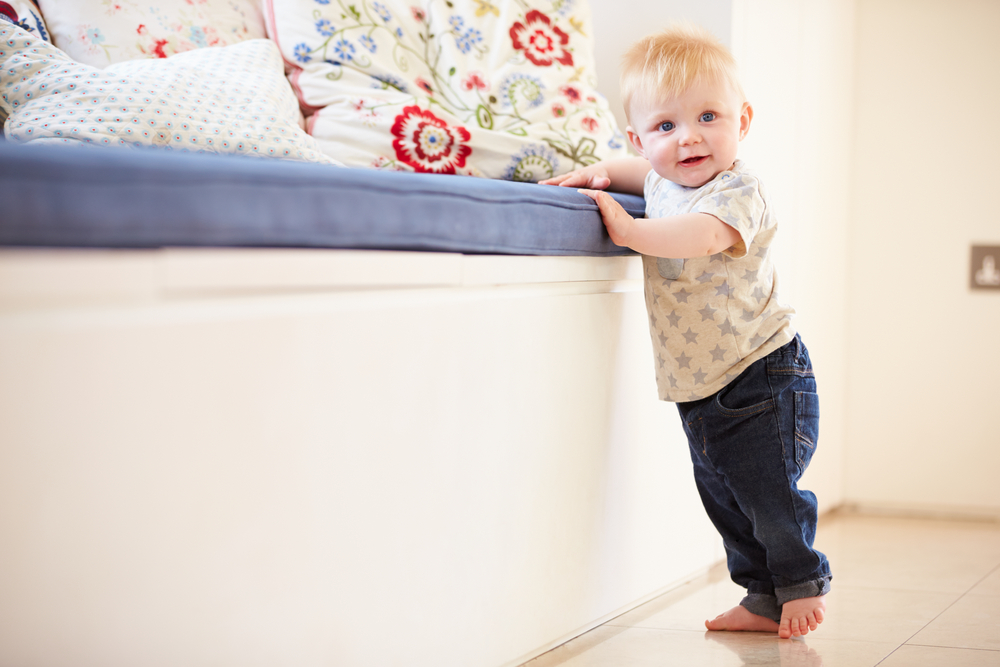Let’s Grow Pediatrics is here to share tips to help your child take their first steps safely as they begin walking.
Walking: A Major Milestone For Your Child
Taking those very first steps is among the numerous thrilling and cherished landmarks in your child’s growth journey. Right from early stages, your baby has been gearing up for this momentous occasion of walking. All those instances of rolling, sitting up, bottom shuffling, crawling, cruising along furniture, and standing have now converged into your baby’s latest escapade: taking their first steps.
Typically, babies commence walking somewhere within the range of 10 to 18 months. Prior to these first steps, babies commonly engage in crawling (typically occurring between 7 and 12 months) and pulling themselves up to a standing position (usually unfolding between 9 and 12 months).
What Skills Does A Baby Develop In Order To Start Walking?
- Adequate muscle strength, particularly in the legs, is essential for supporting the body’s weight during standing and walking. Infants typically develop this strength through activities like tummy time, crawling, and pulling themselves up.
- The ability to maintain balance and coordinate movements is crucial for walking. Babies gradually develop these skills through activities that involve shifting their weight, reaching for objects, and exploring their surroundings.
- Before walking, babies need good control over their head and neck muscles to keep their head aligned with their body while in an upright position. This control is honed through activities like tummy time and reaching for objects.
- A stable core helps maintain an upright posture and enables controlled movement. Activities like sitting up, crawling, and reaching for objects contribute to developing core stability.
- Babies typically learn to pull themselves up to a standing position using furniture or other support. Cruising, which involves moving along furniture while holding onto it for support, helps them practice weight shifting and balancing.
- Moving their body weight from one leg to the other is a fundamental skill for walking. Babies often practice weight shifting while standing and cruising.
- Developing visual perception and spatial awareness helps a child assess their environment and obstacles. Crawling and exploring the surroundings contribute to enhancing these skills.
- Proprioception, which is the sense of where one’s body is in space. Babies develop proprioception through experiences like touching objects, feeling surfaces, and exploring different textures.
- A child needs the confidence to take those first steps. This can be influenced by their experiences and interactions with their environment and caregivers.
- While not directly related to walking, fine motor skills contribute to overall development and coordination. Activities that involve picking up small objects and manipulating toys help refine fine motor skills.
What Are Ways To Babyproof The House For A Walking Toddler?
1. Window Safety: Install window guards that limit the window opening to no more than four inches. Opt for cordless window coverings for added safety.
2. Prevent Furniture Tip-overs: Secure heavy furniture, artwork, and even TVs to the wall to prevent them from tipping over.
3. Keep Breakables Away: Store breakable items out of your child’s reach. Remember, it’s higher than you might think.
4. Stair Safety: Install baby gates at the top and bottom of all staircases.
5. Avoid Choking Hazards: Remove any small objects that could be choking hazards. A good rule of thumb is if it can fit through an empty toilet paper roll, it’s not safe.
6. Protect Furniture Edges: Use corner guards to cushion the sharp edges of furniture.
7. Outlet Safety: Block electrical outlets with either furniture or outlet covers.
9. Secure Restricted Areas: Install locks on doors leading to rooms with potential dangers, such as exercise rooms or home offices.
10. Stabilize Wobbly Items: Move unstable objects like lamps behind furniture and out of your baby’s reach.
11. Fireplace and Heater Safety: Block your baby’s access to fireplaces, floor heaters, or radiators to prevent accidents.
11. Install Safety Latches In The Kitchen. This includes low drawers, cabinets, the refrigerator and freezer doors. Install guards on the oven and stove handles as well.
12. Hazardous Cleaning Products. Store all cleaning products both out of reach and out of sight.
13. Babyproof The Bathroom. Instead of leaving small objects out in the shower and counter, put them away. Secure the toilet with a safety latch. And, any appliances with cords, such as hair dryers and flat irons, should be put away as well.
14. Pool Safety. Do not leave your child unattended outdoors if your home has a pool. If possible, a number of parents feel better if a fence can be installed around the pool. Guidelines suggest a fence at least five-feet high.
How Can Physical Therapy Benefit A Child’s Development?
At Let’s Grow Pediatrics, we believe that it is important to catch any signs of developmental delays early. We recommend that if a child has a diagnosis with known associated delays, they should seek a physical therapy referral before any signs of delay become apparent. Our evaluations for developmental disabilities and plagiocephaly begin as early as one month of age.
Let’s Grow can offer several options for physical therapy to meet the development needs of your child. These include the Universal Exercise Unit, which utilizes a pulley and weight system to improve balance, muscle control, and motor skills. Dynamic Movement Intervention is also available, with repeated dynamic exercises to boost balance and function. Intensive Physical Therapy is a week-long session focused on posture, movement, and regaining lost milestones. Finally, Muscle and Joint Strengthening can be used to help those with severe injuries regain range of motion and control.
If you wonder if your child has plagiocephaly or torticollis, call Let’s Grow Pediatrics for a diagnosis and physical therapy care plan. To find out more about our treatment options and how your child can benefit from Pediatric Intensive Physical Therapy, reach out to Let’s Grow Pediatrics in Edmond, OK. Call 405-562-3485 to schedule your consultation today.


